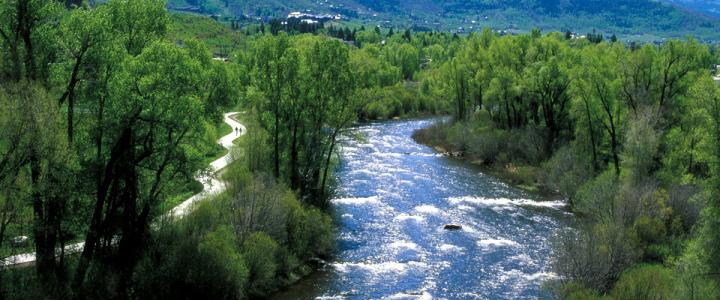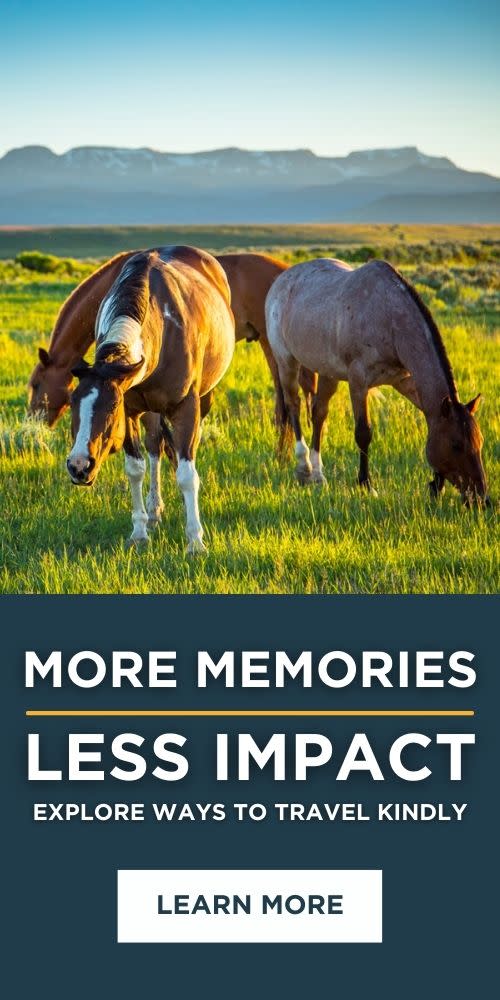
Water is an integral part of Steamboat Springs — historically and today. The Yampa Valley served as the summer hunting grounds for the Ute Indians, Colorado’s oldest documented inhabitants, for hundreds of years. The Yampatika Ute and Arapaho tribes frequented the natural “medicine” springs in the area, considered sacred for their healing properties. The name Steamboat Springs originated in the early 1800s when French trappers mistook the sounds of natural mineral springs for the chugging sound of a distant steamboat’s steam engine. By 1871, ranchers introduced the first cattle to the area and relied on the water to care for their animals and grow crops.
While the construction of the railroad in the early 1900s silenced the chugging sound forever, Steamboat’s rivers, streams, waterfalls, and hot springs remain a vital part of what sets it apart today. We encourage guests to “wade in our boots” and learn more about the history of these unique waters. Understanding what makes our resources special intrinsically motivates visitors to care for them like locals do. Here, Kindness Floats the ‘Boat, so embrace the Western spirit of Steamboat Springs by slowing down, practicing patience, opening doors, smiling big and tipping your hat. It’s the Steamboat way.
RIVERS
The 250-mile-long Yampa River remains the wildest river in the entire Colorado River system (meaning it’s the most free-flowing) and meanders through the heart of Steamboat Springs. Historically, the Yampa was praised by the native Ute Indians for its healing waters. It’s also a fundamental source of fun whether you’re reeling in trout, floating lazily along in an inflatable tube, or paddling the rapids. Just remember to follow the rules of the river — leave dogs, Styrofoam coolers, glass bottles and alcohol at home; wear sturdy sandals or water shoes; go early (before noon); and pitch in to keep the riverbank clean — whether it’s your trash or not. Here are some ways to experience the Yampa River:
Fly-Fishing – The Yampa is home to native fish such as the Colorado pikeminnow and humpback chub (both of which are scarce elsewhere in the state), as well as trophy-sized rainbow trout. A favorite local pastime, fly-fishing the Yampa is easy thanks to several miles of public access in town. Additional popular access points include the headwaters in White River National Park and its tributary, Bear River, near the town of Yampa. New to the sport? We recommend going with a guide. Bucking Rainbow Outfitters offers a three-hour clinic perfect for newbies.
Tubing – Experience downtown Steamboat Springs from the comfort of an inner tube. Tubing season typically begins in June and can last through August, depending upon river flow. Experts recommend going with a local outfitter who provides shuttle service and tube rentals, including Backdoor Sports, Bucking Rainbow Outfitters, and Switchback Sports.
Paddle Sports – The Yampa’s flow is great for standup paddleboarding, whitewater kayaking and rafting (flow-dependent). Most raft trips on the Yampa start at the section near Steamboat Ski Resort, navigating a few exciting whitewater runs before chugging straight through downtown. A popular kayak run is along the 25-mile stretch of water between the town of Yampa and Steamboat, where the water ranges between Class I and III and weaves through small canyons and lush ranch lands. Both Backdoor Sports and Bucking Rainbow Outfitters offer daily kayak, raft, and stand-up paddleboard trips and rentals. Or visit local manufacturer and water gear specialist Hala Gearspace to rent or buy gear.
WATERFALLS
The 280-foot Fish Creek Falls funneling through massive, exposed cliffs has long been one of the most popular destinations in Steamboat Springs. According to a Steamboat Pilot newspaper story dated July 10, 1986, the area was first homesteaded in 1901 by the Williams and Crawford families. Avid fishermen, the Crawfords coined the area’s name as whitefish and brooktrout often spawned there in the autumn. In the early 1900s, the whole town would gather with pitchforks, hooks and gunny sacks to catch fish to be salted and stored in barrels for winter. In the 1930s, the Civilian Conservation Corps constructed roads, trails and campground facilities in the area. While the property was still privately owned, it was maintained by the Forest Service until the 1950s and later by the City of Steamboat. After the land was nearly sold for development in the ‘70s, a concerned citizen named Bob Adams went to work. He wanted to preserve the area for future generations and worked tirelessly to secure a land trade to keep it public. In 1984, the Routt National Forest officially acquired the 240-acre tract of land. Soon after, local citizens met to brainstorm improvements and plans to protect the land, and build a wheelchair-accessible viewpoint that still exists today.
See the falls without the crowd and opt for a moderate hike on single-track to Upper Fish Creek Falls (2.5 miles one-way) and Long Lake (6.5 miles one-way) deep in Routt National Forest. Upper Fish Creek Falls is snuggled in a rocky cleft along the heights of a hanging valley, making the trek as breathtaking as the destination. While the falls are open daily year-round, the best times to visit are May through Sept. Avoid mid-day and come in the early morning or late afternoon (it’s open from 6 a.m. to 10 p.m.). Hiking is free; parking is limited and costs $5 per vehicle. Bring water in a reusable water bottle. Don’t have one? Stop by the Steamboat Springs Visitor Center to score a free bottle.
HOT SPRINGS
Steps away from the restaurants and shops of downtown Steamboat discover seven natural mineral springs, each with its own history, medicinal uses, and geologic past. Take a self-guided mineral springs walking tour and retrace the footsteps of the Northern Ute Indians and early homesteaders. Brochures are available at the Tread of Pioneers Museum and online. Of course, don't miss Old Town Hot Springs to take a dip for yourself and explore the healing waters of the Heart Spring, splash around with the family, and even try the cold plunge.
DRINKING THE WATER
Aside from providing great recreation, Steamboat Springs boasts some of the best drinking water around. The quality (and taste) of the water is unrivaled even by bottled waters. Mount Werner Water utilizes two water sources to serve Steamboat Springs. The main source is the Fish Creek Filtration Plant, which draws water from Fish Creek and Fish Creek Reservoir. The second, typically seasonal source, is the Yampa Well System, which draws from the Yampa River Alluvium. Water from each source undergoes rigorous filtration, monitoring, and testing before it comes out of the tap. Remember to bring your reusable water bottle everywhere you go in Steamboat Springs to help reduce plastic waste. If you don’t have one, stop by the Steamboat Springs Visitor Center for a free bottle!
MORE RESOURCES —
For the latest information on Colorado Parks & Wildlife (including state park openings and campsite status), visit www.cpwshop.com/.
For the latest information from the City of Steamboat Springs, visit www.steamboatchamber.com/traveler-information/.
For the latest information from the U.S. Forest Service (including national park openings and campsite status), visit www.fs.usda.gov/about-agency/covid19-updates.






